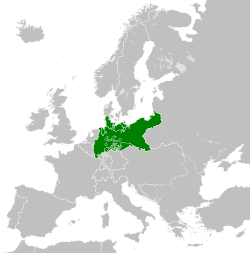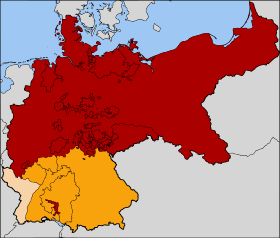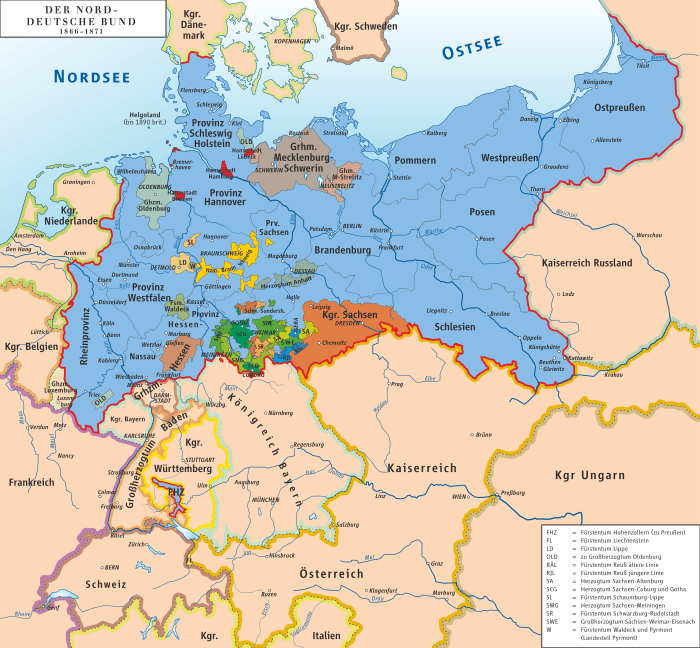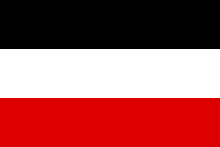North German Confederation
| North German Confederation | ||||||||||||||||
| Norddeutscher Bund | ||||||||||||||||
| ||||||||||||||||
| ||||||||||||||||
 The North German Confederation within Europe circa 1870 | ||||||||||||||||
 The North German Confederation (red). The southern German states that joined in 1870 to form the German Empire are in orange. Alsace-Lorraine, the territory annexed following the Franco-Prussian War of 1871, is in tan. The red territory in the South marks the original princedom of the House of Hohenzollern, rulers of the Kingdom of Prussia. | ||||||||||||||||
| Capital | Berlin | |||||||||||||||
| Languages | German, Danish, Low German, Czech, Lithuanian, Polish, Sorbian | |||||||||||||||
| Religion | Majority: Protestant (Lutheran, Reformed, Prussian United) Minorities: | |||||||||||||||
| Political structure | Confederation | |||||||||||||||
| President | ||||||||||||||||
| • | 1867–1871 | William I | ||||||||||||||
| Chancellor | ||||||||||||||||
| • | 1867–1871 | Otto von Bismarck | ||||||||||||||
| Legislature | Reichstag | |||||||||||||||
| • | Federal Council | Bundesrat | ||||||||||||||
| Historical era | New Imperialism | |||||||||||||||
| • | Confederation Treaty | 18 August 1866 | ||||||||||||||
| • | Constitution adopted | 16 April 1867 | ||||||||||||||
| • | Franco-Prussian War | 19 July 1870 | ||||||||||||||
| • | Unification of Germany | 18 January 1871 | ||||||||||||||
| Currency | Vereinsthaler | |||||||||||||||
| ||||||||||||||||
| Today part of | | |||||||||||||||

The North German Confederation (German: Norddeutscher Bund[1]) was a confederation of 22 previously independent states of northern Germany, with nearly 30 million inhabitants. It was the first modern German nation state and the basis for the later German Empire (1871–1918), when several south German states such as Bavaria joined.
After several unsuccessful proposals from several sides to reform the German Confederation (founded in 1815), the North German major power Prussia left the German Confederation with some allies. It came to war between those states on one hand and southern states led by Austria on the other. After a quick decision in the Austro-Prussian War of July 1866, Prussia and its allies founded the North German Confederation. At first, it was a military alliance between independent states, the so-called August Alliance (August-Bündnis), but the states already had the intention to form a federation or confederation with a constitution. This was realised in 1867. The North German Confederation is historically important for the economic and judicial unification of Germany; many of its laws were taken over by the German Empire.
The North German Confederation continues as the German nation state which still exists today. On January 1st, 1871, the country received a new constitution that gave it the name 'German Empire'.
History
Until the constitution of 1867
In 1815, after the final defeat of Napoleon, the German princes and free cities established the German Confederation as a successor of the former Holy Roman Empire. The sovereignty remained with the individual German states. There were several attempts to create a modern nation state, most prominently in the Revolution of 1848. A major issue in the struggle was the rivalry between Austria, the traditional principal power in Germany, and the ascending Prussia. The Austro-Prussian War of 1866 demonstrated the military superiority of Prussia, led by its ingenious and energetic minister-president Otto von Bismarck.
After the war Prussia annexed most of its adversaries' territories north of the river Main, such as the Kingdom of Hanover, and with the other North German states it signed on 18 August the North German Confederation Treaty. The alliance had 15 members then, with 80 percent of the inhabitants living in Prussia. A notable exclave of the North German Confederation was the Prussian territory of Hohenzollern in the south. Hesse-Darmstadt was part of the new Confederation only with its northern part. A South German Confederation, as mentioned in the Peace of Prague, did not come into existence.
From the beginning the alliance was supposed to become a nation state with a federal constitution. On 15 December 1866, Bismarck presented a proposal to the representatives of the allied governments. Their complaints did not seriously alter the proposal. On 7 February 1867, the common proposal of the governments was ready. It was the intention not to impose the new constitution but to stipulate it together with a representation of the people. To this end a parliament was elected on 12 February. This Konstituierender Reichstag accepted the constitution, with relatively minor changes, on 16 April 1867. Then, the state parliaments adopted it. It became law on 1 July. Consequently, the first (constitutional) North German Reichstag was elected, the only one during the (following) existence of the North German Confederation. Bismarck became the first and only North German Bundeskanzler, the one person federal executive.
Three years of legislation
The constitution opened the Confederation for the south German states to join. But in the situation of 1866/1867, France would not have accepted such an enlargement of Prussia's power. Bismarck, shortly after the war with Austria and amid negotiations about the constitution, could not afford a military conflict with France.[2]
During the roughly four years of the North German Confederation its major action existed in legislation unifying Northern Germany. The Reichstag decided on laws concerning (e.g.):
- free movement of the citizens within the territory of the Confederation (1867)
- a common postal system (1867/1868)
- common passports (1867)
- Prussian military laws replacing local military regulation (1867)
- equal rights for the different denominations (1869)
The North German Confederation became a member of the Zollverein, the German customs union of 1834. After negotiations in 1867, on 1 January 1868 it was transformed to a closer organisation with new institutions: a council for the governments and a parliament. Bismarck hoped that the Zollverein might become the vehicle of German unification. But in the 1868 Zollverein elections the South Germans voted mainly for anti-Prussian parties.
German Empire
In mid-1870, a diplomatic crisis concerning the Spanish throne led eventually to the Franco-Prussian War.[3] During the war, in November 1870, the North German Confederation and the south German states of Bavaria, Württemberg, and Baden (together with parts of the Grand Duchy of Hesse which had not originally joined the confederation) united to form a new nation state. It was originally called Deutscher Bund (German Confederation), but on 10 December 1870 the Reichstag of the North German Confederation adopted the name Deutsches Reich (German Realm or German Empire) and granted the title of German Emperor to the King of Prussia as Bundespräsidium of the Confederation.[4] On 1 January 1871 the new constitution gave the country the name 'German Empire' and the title of Emperor to King William. He accepted the title on 18 January 1871.
A new Reichstag was elected on 3 March 1871. The constitutions of 1 January and 16 April 1871 constitution of the Empire were nearly identical to that of the North German Confederation, and the Empire adopted the North German Confederation's flag.
Political system

The North German Constitution of 16 April 1867 created a national parliament with universal suffrage (for men above the age of 25), the Reichstag. Another important organ was the Bundesrat, the 'federal council' of the representatives of the allied governments. To adopt a law, a majority in the Reichstag and in the Bundesrat was necessary. This gave the allied governments, meaning the states and their princes, an important veto.
Executive power was vested in a president, a hereditary office of the House of Hohenzollern, the ruling family of Prussia. He was assisted by a chancellor responsible only to him — an office that Bismarck designed with himself in mind. There was no formal cabinet; the heads of the departments were not called ministers but secretaries. Those were installed and dismissed by the chancellor.
For all intents and purposes, the confederation was dominated by Prussia. It had four-fifths of the confederation's territory and population — more than the other 21 members combined. The presidency was a hereditary office of the Prussian crown. Bismarck was also foreign minister of Prussia, a post he held for virtually his entire career. In that role he instructed the Prussian deputies to the Bundesrat. Prussia had 17 of 43 votes in the Bundesrat despite being by far the largest state, but could easily get a majority by making alliances with the smaller states.

Postage stamps
One of the functions of the confederation was to handle mail and issue postage stamps; for details, see postage stamps and postal history of the North German Confederation.
List of member states
| State | Capital | |
|---|---|---|
| Kingdoms (Königreiche) | ||
| |
Prussia (Preußen) (including Lauenburg) |
Berlin |
| |
Saxony (Sachsen) | Dresden |
| Grand Duchies (Großherzogtümer) | ||
| |
Hesse (Hessen) (Only Upper Hesse, the province north of the River Main) |
Giessen |
| |
Mecklenburg-Schwerin | Schwerin |
| |
Mecklenburg-Strelitz | Neustrelitz |
| |
Oldenburg | Oldenburg |
| |
Saxe-Weimar-Eisenach (Sachsen-Weimar-Eisenach) | Weimar |
| Duchies (Herzogtümer) | ||
| |
Anhalt | Dessau |
| |
Brunswick (Braunschweig) | Braunschweig |
| |
Saxe-Altenburg (Sachsen-Altenburg) | Altenburg |
| |
Saxe-Coburg and Gotha (Sachsen-Coburg und Gotha) | Coburg |
| |
Saxe-Meiningen (Sachsen-Meiningen) | Meiningen |
| Principalities (Fürstentümer) | ||
| |
Lippe | Detmold |
| |
Reuss-Gera (Junior Line) | Gera |
| |
Reuss-Greiz (Elder Line) | Greiz |
| |
Schaumburg-Lippe | Bückeburg |
| |
Schwarzburg-Rudolstadt | Rudolstadt |
| |
Schwarzburg-Sondershausen | Sondershausen |
| |
Waldeck and Pyrmont (Waldeck und Pyrmont) | Arolsen |
| Free and Hanseatic Cities (Freie und Hansestädte) | ||
| |
Bremen | |
| |
Hamburg | |
| |
Lübeck | |
See also
References
- ↑ An alternative translation is "North German Federation."
- ↑ Görtemaker, Manfred (1983). Deutschland im 19. Jahrhundert: Entwicklungslinien. Opladen. p. 241.
- ↑ Görtemaker, Manfred (1983). Deutschland im 19. Jahrhundert: Entwicklungslinien. Opladen. p. 244.
- ↑ Case, Nelson (1902). European Constitutional History. Cincinnati: Jennings & Pye. pp. 139–140. OCLC 608806061.
Further reading
- Craig, Gordon A. Germany, 1866–1945 (1978) pp 11-22 online edition
- Holborn, Hajo. A History of Modern Germany: 1840–1945 (1969) pp. 173–232
- Hudson, Richard. "The Formation of the North German Confederation." Political Science Quarterly (1891) 6#3 pp: 424-438. in JSTOR
- Nipperdey, Thomas. Germany from Napoleon to Bismarck: 1800-1866 (1996), very dense coverage of every aspect of German society, economy and government
- Pflanze, Otto. Bismarck and the Development of Germany, Vol. 1: The Period of Unification, 1815–1871 (1971)
- Taylor, A.J.P. Bismarck: The Man and the Statesman (1967) online edition
Coordinates: 52°31′N 13°24′E / 52.517°N 13.400°E

